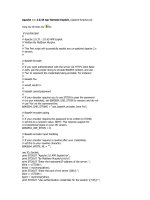Ssl apache ubuntu
Bạn đang xem bản rút gọn của tài liệu. Xem và tải ngay bản đầy đủ của tài liệu tại đây (50.13 KB, 2 trang )
How To Create a SSL Certificate on Apache for
Ubuntu 12.04
About SSL Certificates
A SSL certificate is a way to encrypt a site's information and create a more secure connection. Additionally, the
certificate can show the virtual private server's identification information to site visitors. Certificate Authorities
can issue SSL certificates that verify the server's details while a self-signed certificate has no 3rd party
corroboration.
Set Up
The steps in this tutorial require the user to have root privileges on the VPS. You can see how to set that up here
in steps 3 and 4.
Additionally, you need to have apache already installed and running on your virtual server. If this is not the
case, you can download it with this command:
sudo apt-get install apache2
Step One—Activate the SSL Module
The next step is to enable SSL on the droplet.
sudo a2enmod ssl
Follow up by restarting Apache.
sudo service apache2 restart
Step Two—Create a New Directory
We need to create a new directory where we will store the server key and certificate
sudo mkdir /etc/apache2/ssl
Step Three—Create a Self Signed SSL Certificate
When we request a new certificate, we can specify how long the certificate should remain valid by changing the
365 to the number of days we prefer. As it stands this certificate will expire after one year.
sudo openssl req -x509 -nodes -days 365 -newkey rsa:2048 -keyout
/etc/apache2/ssl/apache.key -out /etc/apache2/ssl/apache.crt
With this command, we will be both creating the self-signed SSL certificate and the server key that protects it,
and placing both of them into the new directory.
This command will prompt terminal to display a lists of fields that need to be filled in.
The most important line is "Common Name". Enter your official domain name here or, if you don't have one
yet, your site's IP address.
You are about to be asked to enter information that will be incorporated
into your certificate request.
What you are about to enter is what is called a Distinguished Name or a DN.
There are quite a few fields but you can leave some blank
For some fields there will be a default value,
If you enter '.', the field will be left blank.
----Country Name (2 letter code) [AU]:US
State or Province Name (full name) [Some-State]:New York
Locality Name (eg, city) []:NYC
Organization Name (eg, company) [Internet Widgits Pty Ltd]:Awesome Inc
Organizational Unit Name (eg, section) []:Dept of Merriment
Common Name (e.g. server FQDN or YOUR name) []:example.com
Email Address []:
Step Four—Set Up the Certificate
Now we have all of the required components of the finished certificate.The next thing to do is to set up the
virtual hosts to display the new certificate. Open up the SSL config file:
nano /etc/apache2/sites-available/default-ssl
Within the section that begins with <VirtualHost _default_:443>, quickly make the following changes. Add a
line with your server name right below the Server Admin email:
ServerName example.com:443
Replace example.com with your DNS approved domain name or server IP address (it should be the same as the
common name on the certificate). Find the following three lines, and make sure that they match the extensions
below:
SSLEngine on
SSLCertificateFile /etc/apache2/ssl/apache.crt
SSLCertificateKeyFile /etc/apache2/ssl/apache.key
Save and Exit out of the file.
Step Five—Activate the New Virtual Host
Before the website that will come on the 443 port can be activated, we need to enable that Virtual Host:
sudo a2ensite default-ssl
You are all set. Restarting your Apache server will reload it with all of your changes in place.
sudo service apache2 reload
In your browser, type https://youraddress, and you will be able to see the new certificate.
Source: />









